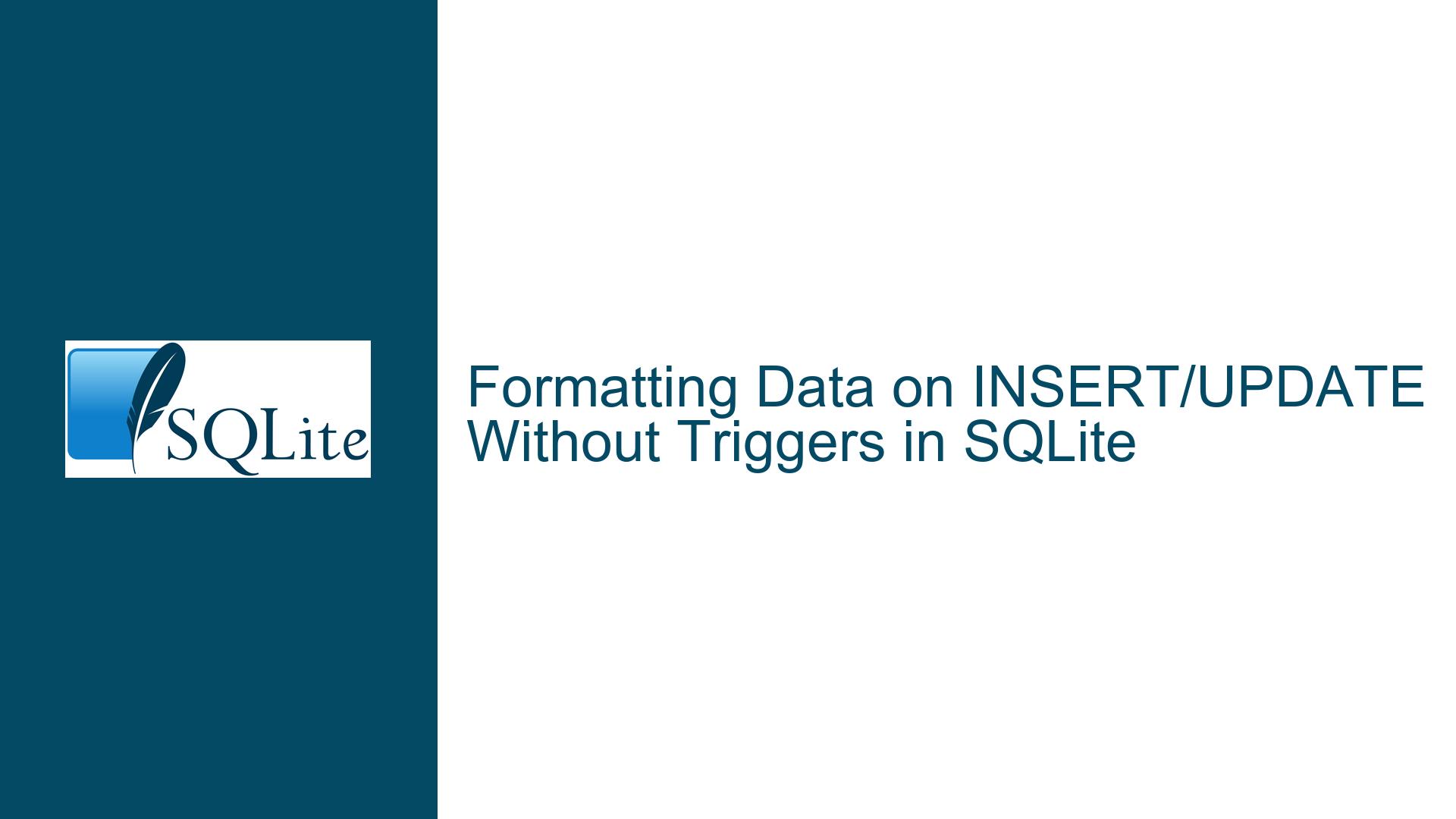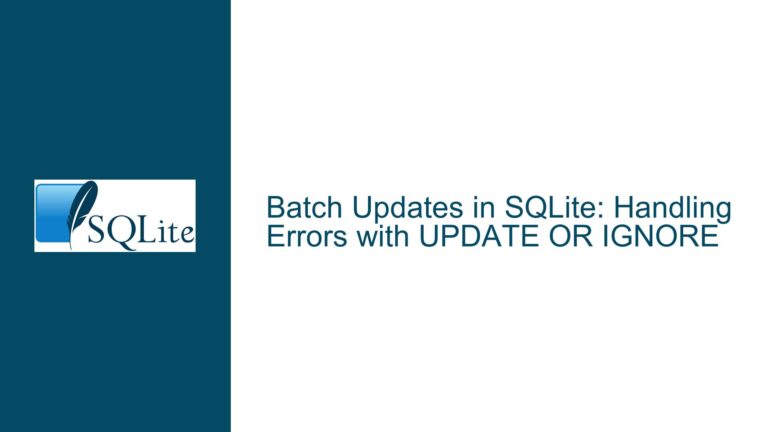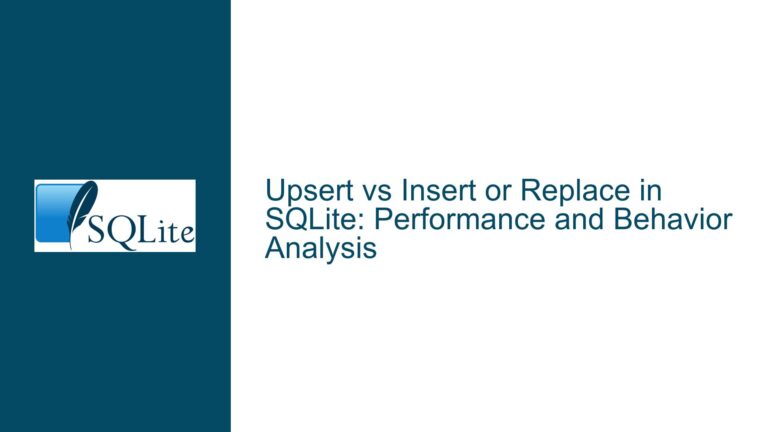Formatting Data on INSERT/UPDATE Without Triggers in SQLite
Transforming Data During INSERT/UPDATE Operations
When working with SQLite, a common requirement is to format or transform data during INSERT or UPDATE operations. For instance, you might want to convert a string to lowercase and replace specific characters (e.g., dashes with colons) before storing it in the database. This transformation ensures data consistency and can simplify subsequent queries by enforcing a uniform format. However, SQLite does not provide a built-in mechanism at the table definition level to automatically transform data during INSERT or UPDATE operations, unlike CHECK constraints which validate data.
The challenge arises when you want to perform these transformations without using triggers. Triggers are a powerful tool in SQLite, allowing you to execute custom logic before or after INSERT, UPDATE, or DELETE operations. However, they introduce additional complexity and overhead, which might not be desirable in all scenarios. Therefore, the question becomes: Is there a way to achieve data transformation during INSERT/UPDATE operations without relying on triggers?
Limitations of SQLite’s Table Definition and Constraints
SQLite’s table definition capabilities are somewhat limited when it comes to data transformation. While you can enforce constraints like CHECK to validate data, there is no direct way to modify or transform data before it is stored. For example, a CHECK constraint can ensure that a value meets certain conditions, but it cannot alter the value itself. This limitation means that any data transformation must occur either before the data is passed to the INSERT/UPDATE statement or within the statement itself.
One approach is to use SQL functions like LOWER() and REPLACE() directly within the INSERT or UPDATE statement. For example, if you want to insert a value into a column while converting it to lowercase and replacing dashes with colons, you can write:
INSERT INTO t(a, b) VALUES (111, REPLACE(LOWER(:myparam), '-', ':'));
This approach works well if you have control over the INSERT/UPDATE statements. However, it becomes problematic if the statements are generated by an ORM (Object-Relational Mapping) tool or another layer of abstraction that you cannot easily modify. In such cases, you might not be able to inject the necessary transformation logic directly into the SQL statements.
Another limitation is that SQLite does not support computed columns in the same way as some other databases. While SQLite introduced generated columns in version 3.31.0, these columns are computed based on other columns in the same row and cannot directly transform data during INSERT/UPDATE operations. Generated columns are useful for deriving values from existing data, but they do not solve the problem of transforming input data before it is stored.
Leveraging SQL Functions and Generated Columns for Data Transformation
Given the limitations of SQLite’s table definition capabilities, the most practical solution for transforming data during INSERT/UPDATE operations is to use SQL functions directly within the statements. This approach requires that you have control over the SQL statements being executed, either by writing them manually or by modifying the code that generates them.
For example, consider a table t with columns a and b. If you want to insert a value into column b while converting it to lowercase and replacing dashes with colons, you can use the following INSERT statement:
INSERT INTO t(a, b) VALUES (111, REPLACE(LOWER(:myparam), '-', ':'));
In this statement, :myparam is a placeholder for the input value. The LOWER() function converts the value to lowercase, and the REPLACE() function replaces dashes with colons. This approach ensures that the data is transformed before it is stored in the database.
If you need to perform the same transformation during an UPDATE operation, you can use a similar approach:
UPDATE t SET b = REPLACE(LOWER(:myparam), '-', ':') WHERE a = 111;
This statement updates the value of column b for the row where column a equals 111, applying the same transformation as in the INSERT statement.
While this approach works well for simple transformations, it can become cumbersome if you need to apply the same transformation logic across multiple tables or columns. In such cases, you might consider creating a helper function in your application code to perform the transformation and then pass the transformed value to the SQL statement. This approach centralizes the transformation logic and makes it easier to maintain.
Another option is to use generated columns to store a transformed version of the data. For example, you could create a table with a generated column that automatically converts the value of another column to lowercase and replaces dashes with colons:
CREATE TABLE t (
a INTEGER PRIMARY KEY,
b TEXT,
b_transformed TEXT GENERATED ALWAYS AS (REPLACE(LOWER(b), '-', ':')) STORED
);
In this table, the b_transformed column is a generated column that always contains the transformed version of the b column. When you insert or update a row, the b_transformed column is automatically computed based on the value of b. This approach allows you to store both the original and transformed values, which can be useful if you need to preserve the original data for auditing or other purposes.
However, generated columns have some limitations. They are computed based on other columns in the same row, so they cannot be used to transform input data directly. Additionally, generated columns are only available in SQLite version 3.31.0 and later, so this approach is not available in older versions of SQLite.
In summary, while SQLite does not provide a built-in mechanism for transforming data during INSERT/UPDATE operations at the table definition level, you can achieve the desired result by using SQL functions directly within the INSERT/UPDATE statements or by leveraging generated columns. These approaches require that you have control over the SQL statements being executed and may involve some additional complexity, but they provide a way to enforce data consistency without using triggers.






